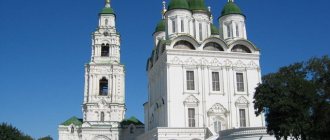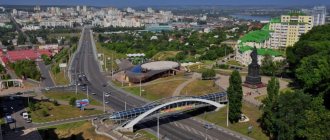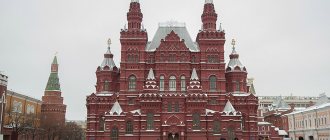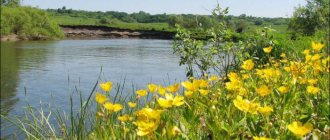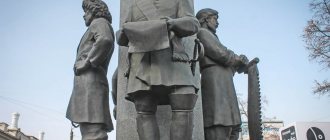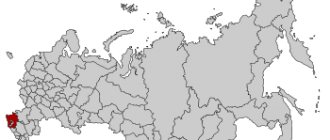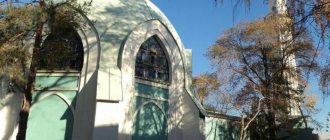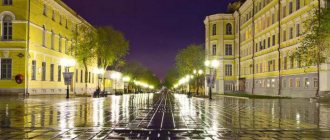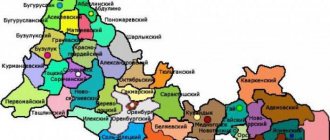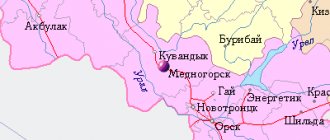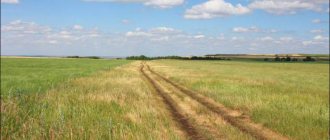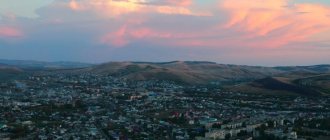In the south of the Urals, 1441 kilometers from Moscow on the Ural River lies a city that ranks 28th in terms of population among Russian settlements - the city of Orenburg . The Orenburg region neighbors Kazakhstan, Tatarstan, Saratov and Samara regions. The length of the region is truly amazing; from west to east it is 755 km, and from north to south 425 km.
Orenburg boasts an unusual history of its founding. The city was founded three times: the first time at the confluence of the Ori River with the Yaik River, the second time the fortress was founded on Red Mountain, and the third time at the site of its modern location on the banks of the Urals. The founder of the city was the scientist, geographer and politician I.K.
Kirilov, who founded the fortress at the behest of Anna Ionovna with the aim of further development of the lands of Siberia. Why did Kirilov call the city Orenburg? The name was chosen because Orenburg was planned as a fortified city on the banks of the Ori.
In 1938, Orenburg was renamed Chkalov in honor of a Soviet pilot who had nothing to do with the city. In 1957, Orenburg was returned to its original name
The impetus for the rapid development of the city was the discovery of a gas field in the 70s of the last century. Orenburg today is a modern, well-maintained city with developed infrastructure and industry.
Climatic conditions of Orenburg
Orenburg belongs to a zone of moderate continental type of climate, which turns into sharply continental. This fact has a direct impact on the sharp fluctuations in the average annual temperature in the region. So in summer the air can warm up to 40 or even 43 degrees, and in winter the temperature can drop to -45 degrees; the temperature minimum was recorded in 1942 and was -49 degrees. The average annual temperature is 5.3 degrees.
Autumn in Orenburg is short, it begins in September, and in November winter comes into its own. The weather in winter is unstable: severe frosts are replaced by a slight minus. At the end of March, spring begins in the city, but even at the end of May, cold weather can unexpectedly return to the region. Summer is short but quite hot, starting in June and ending at the end of August. There is little precipitation, which often leads to droughts.
Moreover, in the west and north of the Orenburg region there is slightly more precipitation than in the east and south. There is a trend: the further east and south, the drier.
Snow in Orenburg falls already by the beginning of November and remains until April. Moreover, the snow cover reaches its maximum height in March. The region is characterized by severe snowstorms with gusty winds, wet sticky snow or even rain. Blizzards appear due to the influence of southern and western cyclones that pass through the region. On average, there are about 50 days with blizzards per year.
It is not surprising that there are a lot of thunderstorms in Orenburg - there are about 20-30 thunderstorm days every year, most of them in July.
Space Museum
The Museum of Cosmonautics is located in the flight school where famous pilots of the country trained: Yu. Gagarin , V. Lebedev , Yu. Lonchakov and others. For a long time, the largest exhibit of the museum stood in front of the building - the MiG-15 aircraft Yuri Gagarin flew in 1961 . The school recently celebrated its 95th anniversary. Over its history, it has trained 28 thousand pilots and navigators. Of these, there were 252 Heroes of the Soviet Union, 10 twice Heroes of the Soviet Union and 4 cosmonauts!
The pilots of this school were the first in history to master the skies over the Arctic and Antarctic . In 1963, the first cosmonaut school in the Soviet Union . And then the cosmonautics museum . Part of the collection included personal belongings of Yu. Gagarin and his flight log.
In 1993, the school was disbanded. Within these walls is located the cadet flight school, the first stage of training. The local residents gave the educational institution a funny name: among themselves they call it “letka.”
Ecology of Orenburg
The environmental situation in Orenburg cannot be called favorable, since there are many industrial enterprises operating in the city that have a direct impact on the cleanliness of the air. The region occupies a leading position in the ranking of cities with the highest emissions of harmful substances into the atmosphere, hydrosphere and soil. Thus, about 900 thousand tons of pollutants are released into the air every year. Among the cities of the Urals, Orenburg is second only to the Chelyabinsk and Sverdlovsk regions in this indicator.
In general, the region is home to more than 14 thousand enterprises and mineral deposits that have a direct impact on the environment, including 74 chemical plants and 130 oil and gas fields. Metallurgical and fuel and energy enterprises account for about 47% of all emissions.
A large number of vehicles, including private ones, have a significant impact on air cleanliness. It accounts for an average of 63% of total emissions into the atmosphere. Moreover, from year to year this figure is becoming higher and higher.
The situation in the region with clean drinking water is also difficult. Not all the water that comes through the pipeline to the homes of city residents meets all the standards and indicators of good drinking water. Urban landfills contribute to the pollution of underground sources, because the movement of water occurs in the direction from the landfills.
Population of Orenburg
According to the latest data, 565,341 people live in Orenburg. It cannot be said that the city’s population is constant, far from it. In the period from 1863 to 1995 it constantly increased, but from 1996 to 2001 and from 2004 to 2009 it steadily decreased. Since 2012, the population has been growing, which can be explained by both rising birth rates and migration from neighboring regions. What attracts migrants to Orenburg? Of course, work. Here they work in agricultural and industrial enterprises, on numerous construction sites and in mining operations.
Orenburg is a multinational city. Representatives of more than 100 nationalities live here. Russians account for about 83.5% of the total population, in second place are Tatars, they number 7.8%, Kazakhs 2.0%, slightly less Ukrainians, there are 1.97%, 1.1% Bashkirs, 0.63 % Armenians and 0.52% Mordovians.
Despite such a multinational composition, interethnic conflicts almost never happen in the city; Orenburg is a friendly city. The proximity of different peoples has led to the fact that the culture and life of the local population consists of an interweaving of traditions and represents a close interaction of ethnic cultures.
Orenburg residents, as a rule, speak two languages. Absolutely everyone knows Russian as a state language. The second language is the national language, the one spoken in the family or among representatives of the same nationality.
Among the age groups in Orenburg, the working age population predominates, accounting for about 67%, while pensioners account for only 17%. As for the working population, Russians, as a rule, work in industrial enterprises, while Kazakhs and Mordovians work primarily in agricultural enterprises in the region.
Museum of Taras Shevchenko
For the 175th anniversary of Orenburg, a museum-guardhouse was opened . Taras Shevchenko was arrested here . The museum is small, but quite realistically reflects the gloomy spirit of the prison premises of the 19th century. There are thick bars on the windows, small cold cells, sparse furnishings.
The formidable guards (wax figures) add realism to the guardhouse. One of the rooms displays the artist’s personal belongings. Museum workers say that Taras Shevchenko violated the emperor’s ban on painting, as he had to devote all his time to military affairs. This is why he ends up here. And even influential friends could not help him. In addition to the permanent exhibition, the museum organizes temporary exhibitions. Most often these are paintings by local artists.
Famous people of Orenburg
The history of Orenburg is inseparable from the life and work of its inhabitants. The Orenburg land was glorified by many famous people of our country. A. S. Pushkin came here in 1833, the poet collected information in the city about the Pugachev uprising, which, as we know, swept the Orenburg land. Later, based on the materials received, Pushkin wrote his “Captain's Daughter”.
The Orenburg land is connected with the life and work of I. A. Krylov, G. R. Derzhavin, N. M. Karamzina, A.N. Pleshcheeva. N. I. Yeltsin, L. A. Guzeeva were born here, the famous conductor M. L. Rostropovich spent his childhood here, P. A. Strepetova M. M. Tarkhanov performed on the stage of the local drama theater, actor L. S. lived in the city. Bronevoy and actress A. Ya. Sadovskaya, poet T. G. Shevchenko served.
The title of Honorary Citizen of the city was awarded to 41 people, including cosmonaut Yu. A. Gagarin, conductor M. L. Rostropovich, politician, minister S. Yu. Witte.
House-Museum of the Gagarins
In 1961, Yuri Gagarin flew into space. This was an important event for all humanity. It became especially important for Orenburg , where Gagarin lived for many years. Here he graduated from flight school and found a family in the same city. In the center of the city there is an old merchant mansion, which once housed the Gagarin family , and since 2001 a memorial house-museum . Initially, this was the apartment of Valentina Goryacheva (Gagarina) , but when she married Yuri , the couple lived here for a long time. After moving to Star City , Yuri and Valentina Gagarin periodically visited Orenburg and stayed in this apartment. Most of the items belonged to the astronaut's family, and photographs from the family archive are also presented.
Economy of the region
Orenburg is a city with a developed diversified economy. There are enterprises in the gas production and gas processing, construction, chemical, metalworking, light, food, and electrical industries operating here.
Orenburg is home to Europe's largest gas condensate field, as well as about 2,500 deposits of various minerals, including rare and non-ferrous metals, jasper, iron ore, brown coal, oil and rock salt.
Industry accounts for 55% of the region's GDP, and more than 25% of the working-age population works here.
The region is actively developing oil fields. Work is underway to identify new deposits. So far, 192 gas and oil fields have been found in the region, 165 structures have been prepared for drilling, and 254 promising structures have been identified.
Due to the presence of explored mineral deposits in the region, the metallurgical industry is developed in the Orenburg region, and metallurgical enterprises can without a doubt be called city-forming. Currently, about 30% of all products produced by the region's industry come from metallurgy. Moreover, 8% of total industrial production belongs to non-ferrous metallurgy.
Mechanical engineering is also developed in the region - transport, agricultural and machine tool manufacturing; about 70 large enterprises operate in this industry.
We cannot ignore the region's agriculture. There are enterprises here that specialize in both livestock and crop production. Moreover, more than seven thousand small, medium and large enterprises in this industry operate in the Orenburg region.
Shawl Museum
The down scarf began to be made in the Orenburg province around the 18th century. The museum displays historical exhibits telling about the emergence and development of this craft. You will experience delight and surprise, because this is a real miracle! A scarf created using ancient technologies can pass through a wedding ring! The secret of its softness and strength is the special fluff provided by local goats. The excursion will be interesting for tourists of any age.
Investments
A unique geopolitical location, a significant amount of labor resources, the potential for the development of natural resources, a well-developed transport infrastructure, and comprehensive interaction with local governments have determined the investment attractiveness of the Orenburg region.
What exactly is Orenburg land attractive for investors?
- favorable geographical location. Orenburg is located between Europe and Asia and is a link between these large markets. The largest transit cargo flows pass here, including from Kazakhstan and Siberia.
- availability of sufficient labor resources. Not only is the region home to more than 2 million people, but the proportion of its working-age population is higher than the national average.
- availability of mineral reserves in the region. Deposits of about 75 types of minerals, including oil and gas, have been discovered in the region.
- favorable natural and climatic conditions, which contributes to the development of both crop and livestock production.
- government support measures for investors.
- developed transport infrastructure. The Orenburg region ranks 7th in Russia in terms of the length of highways. Air traffic is actively developing both within the region and communication with other regions. Transit flows to Tatarstan, Bashkortostan and the cities of the Urals also pass through the Orenburg region. Transport routes connect Orenburg with Chelyabinsk, Samara, and Ufa. The region also has established railway connections with neighboring regions.
It is not surprising that in recent years there has been a positive trend in investment, including foreign investment, in the Orenburg region. Over the past decade, the share of investment in the region has increased three times, the share of foreign investment by 6.8 times, and foreign direct investment by more than 11 times.
Planetarium
The Orenburg Planetarium is 65 years old. It was the eighth planetarium in the country. Initially, during Soviet times, it was located in the building of the Caravanserai , and in the 1980s it was allocated another building.
From the very first minutes, visitors are immersed in the cosmic world. The hall where events take place is brightly decorated. Planets and various spacecraft are located under the ceiling. The windows also display children's works on space themes. The planetarium offers programs for both children and adults. Most of them take place in the form of lectures and films. Equipment with a rotating dome immerses the viewer in outer space. But if you want to watch a real solar eclipse, you will be asked to go to another room where a powerful telescope is installed. It can easily “deliver” you to the rings of Saturn or to the Milky Way .
Enterprises
Enterprises in the chemical, metallurgical, light, food, mining, engineering and other sectors of the economy operate successfully in Orenburg.
The mining industry is represented by:
- Gazprom Dobycha and Gas Processing Plant;
- Ural steel;
- Orenburgneft;
- Yuzhuralnickel;
- Orenburg minerals;
- Copper-sulfur plant in Mednogorsk;
- Orsknefteorgsintez;
- Gai Mining and Processing Plant and others.
Among the large enterprises of ferrous metallurgy, the following can be distinguished:
- Ural steel;
- Mining company;
- Scrap metal company;
- Vtorchermet.
The non-ferrous industry is represented by:
- Cryolite plant;
- Metal structures plant in Orsk;
- Non-ferrous metals processing plant in Gai;
- Copper-sulfur plant in Mednogorsk;
- Nickel plant;
- Gai Mining and Processing Plant and others.
In addition, the following enterprises operate in Orenburg:
- Helium plant;
- Machine tool plant;
- Orenburg radiator;
- Hydropress;
- Orenshal (famous down scarves);
- Oil refinery;
- Construction mixtures plant;
- Polymer pipe plant and others.
The financial sector is represented by both large Russian and commercial banks, including Promsvyazbank, VTB, Avangard, Uralsib, Sberbank, Rus Uniastrum Bank and others.
Construction in the city of Orenburg
Orenburg was built according to the principles of urban planning that appeared in Russia in the 18th century. The city has a central square, and its streets intersect each other at right angles. The buildings that were built in Orenburg before the revolution were erected in the same architectural style and located symmetrically to each other.
It is noteworthy that the historical center of the city was not subject to significant restructuring during Soviet times, and therefore retained its spatial structure, which, unfortunately, cannot be said about the historical flavor. The thing is that numerous churches, towers and cathedrals were destroyed during the Soviet era.
The buildings that were erected in the historical part of the city before the 50s of the last century fit well into the historical appearance of this part of Orenburg. Those buildings that were built later than this date strongly contrast with the previous buildings.
Orenburg acquired its modern appearance in the post-war years, because it was at that time that active development of the city began, primarily with residential neighborhoods. In addition, the expansion of the city also occurred due to the annexation of nearby small settlements to the growing city.
Cable car
In 2006, a cable car was opened Orenburg , which makes it possible to travel from Europe to Asia . Its length is 233 meters. Passengers travel in cozy translucent cabins. This project even took the status of “The most comfortable cable car in Russia” . The speed of your movement through the air will be 3 m/s, so during the flight passengers have time to take pictures of the river, bridge and embankment from a height of 70 meters.
Property value
The level of real estate prices is not constant and changes almost every day. Housing prices depend on the time of year, on the developer, on the type of house, its number of floors, on the area and many other factors
.
The average cost per square meter of an apartment in new buildings in Orenburg as of February 2022 is RUB 39,298.
The official administrative structure of Orenburg is 4 districts: Dzerzhinsky, Leninsky, Industrial and Central.
The most prestigious district of Orenburg is Leninsky (38,639 rubles / sq. m - the cost of new buildings in February 2022 in this area). This location is densely built up, so there are few new buildings here, and most of them appear through compaction development. There are many buildings from the Soviet and perestroika periods; budget options can only be found in panel “Khrushchev” buildings, which are not particularly comfortable.
For commercial real estate, you should go to the Central District - the most densely populated (the cost of new buildings in February 2020 in this area is 39,133 rubles / sq. m). Administrative buildings, retail and entertainment facilities and offices were erected here. Housing is actively sold on the secondary market; prices for lots are not democratic.
Orenburg has budget real estate in the Industrial District (the cost of new buildings in February 2022 in this area is 39,573 rubles/sq. m). The housing stock in this area is quite varied, and the level of infrastructure is not the highest.
The most promising area in the segment of housing under construction is Dzerzhinsky, where new buildings are being actively built today (the cost of new buildings in February 2022 in this area is 38,804 rubles/sq. m). Housing here is still quite affordable, since the social infrastructure and transport system are just taking shape. There are still not enough necessary institutions, and getting to the city center by public transport is quite problematic.
Developers in Orenburg predict an increase in real estate prices due to a fall in the pace of construction. In their opinion, growth will begin in 2020 and continue until 2022. During this period, housing prices, both primary and secondary, can increase by up to 30%.
Popular message topics
- The work of Vladimir Mayakovsky
Mayakovsky was called the main rebel in Russian literature. He had very unusual poems. His personal style of poetic “ladder” aroused envy and indignation among other poets. After all, as you know - Herodotus
Herodotus is one of the most famous historians during the period of ancient Greece. This man was called the “father of history.” Thanks to him, many historical events have reached our times. Herodotus described the war between Greece - Federal Assembly of the Russian Federation
The Federal Assembly is one of the many federal bodies that produces state power in the Russian Federation. Its functions include:
City districts
Orenburg is divided into Southern and Northern districts, as well as into 4 districts: Central, Industrial, Leninsky and Dzerzhinsky.
Leninsky district is considered the most prestigious among city residents; about 179.5 thousand people live here. Real estate prices in this area are the highest in the city, and almost no new housing is being built here due to the lack of available space.
The second most expensive housing area in the city is Central. About 99.7 thousand people live here. The area is characterized by a large number of administrative buildings and dense buildings.
The industrial area is characterized by chaotic development and a rather difficult crime situation. That is why he is not popular among the townspeople.
Dzerzhinsky district is the youngest district of Orenburg, home to about 165.6 thousand residents. The Dzherzhinsky district can without a doubt be called a residential area. Currently, it is being actively built up; more and more new microdistricts are appearing here, which are quickly filled with new buildings.
Victory Park
In summer in Orenburg it is pleasant to walk around the city. It pleases with greenery and fountains. It can even be a pity to waste time on museums. In this case, I recommend visiting an open-air exhibition of military equipment. It is located in Victory Park . Here you can see tanks, planes, self-propelled guns and even trains. The exposition plays out in a very interesting way. You can climb in the trenches, climb onto a train or sit on a cart. Everywhere there are information signs telling about the exhibit.
Attractions
Orenburg is a relatively young city, and therefore lovers of deep antiquity will have nothing to gain here. But, nevertheless, Orenburg is a beautiful and diverse city, because representatives of more than 100 nationalities live here.
The National Village is one of the most interesting attractions of Orenburg. The national village is a cultural complex and even a museum of the multinational population of the city; it is a symbol of friendship between peoples. Here everyone can get acquainted with the history, traditions and culture of different peoples. The National Village is a favorite vacation spot for both Orenburg residents and city guests.
Sovetskaya Street and the embankment of the Ural River are incredibly beautiful. Sovetskaya Street is a pedestrian street of the city; historical buildings are located here. The embankment of the Ural River is an equally interesting place, with views of the grove and the Urals.
Here you can cross the border between Europe and Asia, and also see the monument to the famous Chkalov.
Those who like to stroll through shopping centers should visit Armada; there are about 250 shopping pavilions, both small boutiques and hypermarkets.
Well, lovers of nightlife and nightclubs should check out the Coliseum, the best nightclub in the city. This is where popular DJs from Russia and all over the world play every weekend.
Toy railway
It just seems like the little train and fairytale stations are made for children. In Orenburg, the Children's Railway is the most adult attraction! The road was built not only for skiing, but also to transport parents to country health camps. The railway line runs along the Ural River . Very picturesque landscapes alternate with brightly decorated stations. I recommend everyone to take a ride, not just tourists with children.
